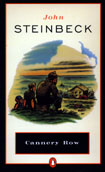Cannery Row
by John Steinbeck
- Introduction
- Before Reading the Novel
- While Reading the Novel
- Teaching Methodology
- After Reading the Novel
- About the Guide Editors
- Buy this Book!
Enter promo code TEACH for 15% off.
This guide is designed to assist teachers in moving students beyond the surface story of Steinbeck's novella. The prereading activities prepare students for what they will read in the novel. The brief discussion of the techniques of plot, character development and theme employed by Steinbeck in his deceptively simple story provides an overview of the story as well as an understanding of its simplicity and complexity. The teaching methodologies are based on response strategies that encourage student interaction with the literary work. Teachers are encouraged to guide, help with reading, and yet allow the students to independently respond to the work.
INTRODUCTIONJohn Steinbeck is one of the greatest storytellers of the twentieth century. His wonderful novellas Cannery Row, The Red Pony, Of Mice and Men, and The Pearl not only introduce readers to a fascinating, realistic cast of characters, make the hills and seacoast of California and Mexico come to life, but also tell intriguing stories of the lives of real people. Steinbeck's characters are not the rich men and women of California's boom days, but are the homeless, the migrant workers, the poor fishermen, and the farmers. However, each of these people has a deceptively simple, but important story to tell, a story filled with love and pain.
Cannery Row, of all Steinbeck's novellas, is the simplest story. It presents a slice of the lives of the men and women who populate a strip of sardine canneries after the workers go home. Set on California's Monterey Peninsula in the days long before famed golf courses and resorts, this post-depression tale depicts of the life of an uproarious cast of characters: Lee Chong, the philosophical grocery store proprietor; Doc, the owner of the Western Biological Laboratory; Dora, the charitable Madame of the Bear Flag Restaurant, Mack, Hazel and Eddie and Hughie and Jones, the well-meaning residents of the Palace Flophouse, and, most important, Cannery Row herself, in all her ugliness and beauty, peace and violence.
BEFORE READING THE NOVELThe overall simplicity of the tale means that it requires only limited prereading teaching. However, some limited prereading information might make it more meaningful to the students.
1. Students may not be familiar with the geography of California's Monterey Peninsula. It would be helpful to locate it on a map, discuss its climate and geographic features, and examine what types of industries are likely to survive in this type of environment.
2. Students who do know this part of West Central California likely know it in late twentieth-century terms as a rich area of tourism, warm climate, and beautiful people. It would be helpful to discuss what it was like in the 1930s before the huge migration to California. Who populated the Monterey Peninsula in those days? How did they make a living? What were their lives like?
3. Because the relationships in Steinbeck's novella are unusual to most students, it might be helpful to discuss the concept of family. What is the traditional concept of family? How many of the students' families do not fit within the traditional concept of family? What is the definition of family? What are some other types of families that fall outside of the traditional concept?






